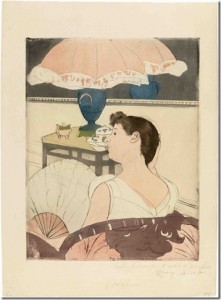Monday’s art – Alison Saar’s “Coup” at the Schneider Museum of Art
via www.sou.edu
Monday’s art was chosen by Ashland, Oregon Slow Art cohost Anne Ashbey.
You can signup for Asland Slow Art Day April 17, 2010 at the Scneider Museum of Art:
http://SlowArtAshland2010.eventbrite.com/
——————————————
About Slow Art and Slow Art day
Run by volunteers like Payal Kripalani, Slow Art and Slow Art Day are designed to help inspire new ways of seeing art.
Facebook list of 45+ cities/museums participating in Slow Art Day April 17, 2010
Web list of 45+ cities/museums participating in Slow Art Day April 17, 2010
Slow Art and Slow Art Day were started by Phil Terry and the Reading Odyssey, a nonprofit dedicated to making lifelong learning accessible and fun for everyone.
Podcast of Homer’s Odyssey discussion for Books 9-16, Feb. 9, 2010
Here’s the podcast for the Reading Odyssey’s Winter 2010 discussion of Homer’s Odyssey Books 9-16.
And a lively discussion it was. Download or listen to complete audio by clicking the button.
Thanks,
Pat Wictor
Xenophon’s Hellenika Books II.3.11-III Study Guide Questions
Hi fellow Xenophon readers,
As you read through the next section of Hellenika in anticipation of our next conference call, here are some questions to help guide you and call attention to particular moments in the text. In the next week, I will be asking some of you to take on a question that will move our discussion along. You may respond in any way you like: with some commentary, some questions that still need to be answered by the group, or both. In the meantime, send our group an email about your reading experience. It has been quite interesting to read not only about the conclusion of a long drawn-out war between Athens and Sparta, but also revealing about the post-war chaos and power vacuum that ensues in a defeated country (Athens). I wonder if anyone sees any comparable historical parallels…
happy reading,
Andre
Xenophon Reading Group 2010
Books II.3.11 – III Study Guide Question
1. The Tyranny of the Thirty
In 404 (Book II.3.11 – 56), the tyranny of the Thirty is called to task by one of their own, Theramenes. Xenophon presents two points of view from within the ranks of the Thirty: Kritias’ accusation and Theramenes’ defense. Athens’ immediate post-war administration is admittedly a scary one. How practical are Kritias’ arguments? How defendable are Theramenes’ arguments, considering what he is being accused of? How is democracy working in Athens at this point? What does this regime remind us of today?
2. Rebellion at Athens
In 403, pro-Athenian exiles led by Thrasyboulos gather to take back Athens from the Thirty. At Athens’ main port (the Peiraieus) the pro-Spartan Athenians are defeated. How do the Spartans react to this threat to Athens? What does the result say about the Spartan ability to run an empire? What does the result say about Athenian independence? (II.4.1 – II.4.43)
3. Sparta vs. Persia
In 401-400 (III.1.1 – III.1.3) – two very important events introduce Book 3: a successful invasion and withdrawal of Greek mercenary troops into Persia (i.e. Xenophon’s Anabasis) in 401 which reveals Persia’s vulnerability and Tissaphernes’ attempt to control Ionian (Greek) cities in Asia Minor. This in turn triggers direct Spartan military intervention on Persian soil in 399-397 (III.1 – III.2.20). How were the Spartan generals Thibron & Derkylidas able to succeed in Asia Minor against the might of Persia? What does Xenophon teach us about the effectiveness of Persian satrapies and administration?
4. Sparta vs. Elis
Sometime around 402-401 (III.2.21 – III.2.31), the Spartans put political pressure on their Peloponnesian neighbor to the north, Elis. The Spartan king Agis leads the war against Elis and eventually achieves a victory. Given the various reasons that Xenophon puts forth for this conflict, what do you suppose was really the root cause? How does this Sparta – Elis conflict reflect Sparta’s ability to control its Peloponnesian allies in general? Looking at Diodorus’ account of this same event in Appendix O (14.17.4-12, 14.34.1), how do the two accounts compare? What does each account emphasize that the other doesn’t?
5. Sparta’s new king?
King Agis’ death around the year 400 brings up the question of Spartan monarchical succession soon after the Spartan-Elis conflict. In Book III.3.1-3, Leotychidas and Agesilaos contend for the kingship. What does Xenophon reveal to us about Spartan dynastic lineage and the power of Spartan queens through this debate between Leotychidas and Agesilaos? (Note: Appendix E, section 22 on pp. 357-358 briefly comments on Xenophon’s exclusion of Spartan women in the Hellenika).
6. Kinadon’s conspiracy?
The first event associated with Agesilaos’ early rule is Kinadon’s conspiracy (III.3.4-11). Given the nature and extent of this conspiracy within Sparta, what do you suppose concerns Xenophon so much by including the account of it in this way? What does this conspiracy say about the state of Sparta’s internal affairs at this time?
7. Agesilaos invades Asia Minor
[recap: After a flashback and digression into Sparta’s internal affairs (see questions #4-6 above), Xenophon picks up the narrative of Spartan military operations in Asia Minor (399-397) left off at III.2.20, when Derkylidas concluded a truce concerning Ionia and its coastal Greek city-states, with two Persian satraps, Tissaphernes (south) and Pharnabazos (north). This truce in 397 resulted in Derkylidas withdrawing Spartan land troops from Persian territory in Asia Minor with the agreement that Ionia be regarded as independent by Persia. It is assumed that Derkylidas was then relieved of his command.]
In the year 396 at the beginning of Book III.4, Agesilaos and Lysander lead an expedition back to Asia Minor and Persian territory in response to Persia’s increase of its naval forces with Phoenician ships. Outnumbered by both Persian land and naval forces, what is Agesilaos’ strategy in dealing with the Persian satraps Tissaphernes and Pharnabazos? How does Agesilaos make the best use of his own troops on the tactical level in individual battles? What is the significance of religion, piety, and sacrifices on Agesilaos’ decisions?
With such detail being given by Xenophon in these chapters, do you suspect that this information is from Xenophon’s own first-hand experience campaigning with Agesilaos? If so, are there any examples of historical detail that stand out more prominently for you in these chapters than in any others before this?
What is the ultimate goal for this Spartan military intervention on Persian soil? How do we know, if at all, that the Spartan mission has been fulfilled? What, if anything, do the Spartans get out of this campaign in the years 396-395 (III.4.1 – III.4.29)?
8. Greece rebels against Sparta
As Xenophon opens III.5 on p. 110, he digresses from Agesilaos’ campaign in Asia (see question #7 above) back to events in Greece in 395. On orders from the Persian king, Tithraustes had just previously eliminated Tissaphernes, a Persian satrap, and directly intervened in negotiations with Agesilaus. With these events going on in Asia, Tithraustes attempts to bribe other Greek city-states to turn against Sparta. To some extent, Persian bribery succeeds in stirring up some unrest among the Greeks against Sparta. Which city-state leads the revolt against Spartan hegemony in Greece? Why do certain Greek city-states decide to actively resist against Sparta? With troops already fighting in Asia Minor and with king Agesilaos far off, why would the Spartans think it prudent to respond to Greek baiting and initiate a second military campaign?
Xenophon includes some stirring rhetoric in III.5.8-15. Given the relations between Athens and Thebes in the Peloponnesian war, how convincing is this speech? How ironic is it from Xenophon’s point of view?
Greek armies clash at Haliartos (III.5.17-24). What is the outcome? What does this battle say about Spartan hegemony over other Greek city-states in 395? What happens to the Spartan king Pausanias in 394 (III.5.25)? What does king Pausanias’ banishment say about Sparta’s leadership at this time?
Performing paintings? Music video for the song “70 million” by “Hold Your Horses”
[vimeo http://www.vimeo.com/9752986 w=500&h=283]
Slow art fans should take a moment to watch this fun and funny music video by the band “Hold Your Horses.” The band members perform paintings.
Friday’s art – Cornelia Parker’s Hanging Fire at the ICA in Boston
via www.facebook.com
Friday’s art was chosen by Boston Slow Art cohost Payal Kripalani.
You can signup for Boston Slow Art Day April 17, 2010 at the ICA:
http://SlowArtBoston2010.eventbrite.com/
——————————————
About Slow Art and Slow Art day
Run by volunteers like Payal Kripalani, Slow Art and Slow Art Day are designed to help inspire new ways of seeing art.
Facebook list of 45+ cities/museums participating in Slow Art Day April 17, 2010
Web list of 45+ cities/museums participating in Slow Art Day April 17, 2010
Slow Art and Slow Art Day were started by Phil Terry and the Reading Odyssey, a nonprofit dedicated to making lifelong learning accessible and fun for everyone.
Thursday’s art – Stanton Macdonald-Wright’s “Synchromy in Purple Minor” at the Blanton Museum of Art
This painting was chosen by Austin Slow Art host Aimee Chang and her colleagues at the Blanton Museum of Art.
You can signup for Austin Slow Art Day April 17, 2010 at the Blanton Museum of Art:
http://SlowArtAustin2010.eventbrite.com/
——————————————
About Slow Art and Slow Art day
Run by volunteers and museum staff around the world, Slow Art and Slow Art Day are designed to help inspire new ways of seeing art.
Facebook list of 45+ cities/museums participating in Slow Art Day April 17, 2010
Web list of 45+ cities/museums participating in Slow Art Day April 17, 2010
Slow Art and Slow Art Day were started by Phil Terry and the Reading Odyssey, a nonprofit dedicated to making lifelong learning accessible and fun for everyone.
Wednesday’s art – Joan Mitchell’s “Bonjour Julie” at the Birmingham Museum of Art.
via www.artnet.com
This painting was chosen by Birmingham Slow Art host Caroline Wingate.
You can signup for Birmingham Slow Art Day April 17, 2010 at the Birmingham Museum of Art:
http://SlowArtBirmingham2010.eventbrite.com/
——————————————
About Slow Art and Slow Art day
Run by volunteers like Caroline Wingate, Slow Art and Slow Art Day are designed to help inspire new ways of seeing art.
Facebook list of 45+ cities/museums participating in Slow Art Day April 17, 2010
Web list of 45+ cities/museums participating in Slow Art Day April 17, 2010
Slow Art and Slow Art Day were started by Phil Terry and the Reading Odyssey, a nonprofit dedicated to making lifelong learning accessible and fun for everyone.
Monday’s art – Mary Cassatt’s “The Lamp” at the Boca Raton Museum of Art
via www.palmbeachartspaper.com
You can signup for Boca Raton Slow Art Day April 17, 2010 at the Boca Raton Museum of Art:
http://SlowArtBocaRaton2010.eventbrite.com/
——————————————
About Slow Art and Slow Art day
Run by volunteers, Slow Art and Slow Art Day are designed to help inspire new ways of seeing art.
Facebook list of 45+ cities/museums participating in Slow Art Day April 17, 2010
Web list of 45+ cities/museums participating in Slow Art Day April 17, 2010
Slow Art and Slow Art Day were started by Phil Terry and the Reading Odyssey, a nonprofit dedicated to making lifelong learning accessible and fun for everyone.
Crocker Art Museum’s Slow Art Day 2010 press release
February 22, 2010 – Sacramento, Calif. – The Crocker Art Museum will be one of more than 40 sites worldwide to host Slow Art Day in 2010, an initiative that encourages visitors to slow down and spend quality time looking at a single artwork.
Thursday’s art: Amy Williams at the 440 Gallery in Brooklyn
via 440gallery.com
If you are in the Brooklyn, New York area, then you can attend Amy Williams’ exhibit at the 440 gallery (see link above).
You can also signup for Brooklyn Slow Art Day April 17, 2010 at the Brooklyn Museum of Art:
http://SlowArtBrooklyn2010.eventbrite.com/
——————————————
About Slow Art and Slow Art day
Run by volunteers, Slow Art and Slow Art Day are designed to help inspire creativity and new ways of seeing art all over the world.
Facebook list of 40+ cities/museums participating in Slow Art Day April 17, 2010
Web list of 40+ cities/museums participating in Slow Art Day April 17, 2010
Slow Art and Slow Art Day were started by Phil Terry and the Reading Odyssey, a nonprofit dedicated to making lifelong learning accessible and fun for everyone.






